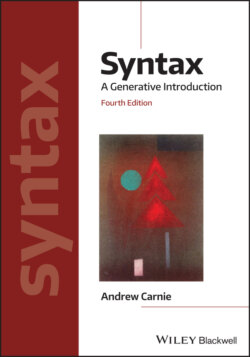Читать книгу Syntax - Andrew Carnie - Страница 18
3. MODELS OF SYNTAX
ОглавлениеOne dominant theory of syntax that fits into the cognitive science mold is due to Noam Chomsky and his colleagues, starting in the mid 1950s and continuing to this day. This theory, which has had many different names through its development (Transformational Grammar (TG), Transformational Generative Grammar, Standard Theory, Extended Standard Theory, Government and Binding Theory (GB), Principles and Parameters approach (P&P) and Minimalism (MP)), is often given the blanket name generative grammar. A number of alternate approaches to syntax have also branched off of this research program. These include Lexical-Functional Grammar (LFG) and Head-Driven Phrase Structure Grammar (HPSG). These approaches are also considered part of generative grammar; but we won’t cover them extensively in this book. But I have included two additional chapters on these theories in the web resources for this book.6 The particular version of generative grammar that we will mostly look at here is roughly the Principles and Parameters approach, although we will occasionally stray from this into the more recent version called Minimalism.
The underlying thesis of generative grammar is that sentences are generated by a subconscious set of procedures (like computer programs). These procedures are part of our minds (or of our cognitive abilities if you prefer). The goal of syntactic theory is to model these procedures. In other words, we are trying to figure out what we subconsciously know about the syntax of our language.
